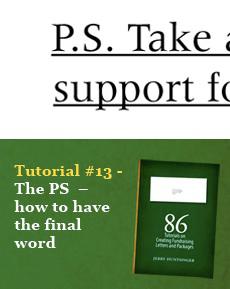Tutorial 13: The PS – how to have the final word
Your PS is a vital selling tool – just as important as the headline. In fact, the PS is often the first and last words your donors read! Why? Human nature, I guess. A postscript arouses curiosity. It’s irresistible.
- Written by
- Jerry Huntsinger
- Added
- February 16, 2019

And it’s both your first and final chance to motivate the donor to take action. Short lines and short paragraphs characterise a good PS. But don’t be afraid to use several paragraphs, as the occasion demands.
Following are 15 suggestions for writing the PS
- Tell the reader exactly what to do, when to do it, how much to give and how to use the reply devices.
PS Enclosed is your World Hunger Day reply card. Please check the $10 gift box and fill in the blank line if you wish to give an additional amount. Then, mail the reply card back to me – before 20 March – in the postage-paid envelope I am providing for you. And thanks so much.
- Ask for immediate action.
PS Can you send your gift today, Mrs. Jones? Every hour’s delay means a longer line at the bush clinic. I must send another doctor and nurse immediately. Perhaps you can sit down this very moment and write your cheque, and then mail it to me in the envelope I am enclosing. Thanks so much.
- Try announcing a deadline.
PS School starts on the 6th September. Can I depend on your help in time to buy a dress for a little girl?
- Limited supply.
PS I only have a limited supply of the health manual available. First come, first served!
Please write me today so you won’t be disappointed. - Limited audience.
PS This appeal is only going to individuals like you who have a unique respect for our National Gallery. That’s why I must depend on your immediate response.
- No strings attached.
PS This inspiring booklet is yours, with no strings attached, in appreciation for your gift of $10 or more.
- Instalment payment.
PS Perhaps you cannot give $100 right now -- but can you send $25 a month for four months? Your continued support will be such a blessing.
Other ways you can use the PS include:
- Restatement of the letter headline.
- Restatement of the offer.
- Restatement of the premium.
- Restatement of how to use the reply devices.
- Restatement of the crisis
Here are a few more:
- Testimonial feature.
PS I must replenish the scholarship fund immediately. Right now a young woman is waiting ... she writes, ‘I am working day and night in order to have an education. But I can’t pay the tuition.’
- Present an additional argument.
PS I almost forgot to mention – if the building contractor can begin work immediately, we will save approximately nine per cent because of the anticipated rise in the cost of steel. Therefore – your immediate gift will serve a double purpose!
- And when all else fails, try a handwritten PS.
PS What more can I say? This problem is desperate – more desperate than you can imagine, unless you were to join me here at the hospital in Bogotá.
Regardless of how you use your PS, never fail to ask for action. This is what a fundraising letter is all about.
One final review: tell your reader exactly what you want her to do. Don’t take anything for granted, spell it out. This serves a dual purpose:
a) You will resolve any questions that may be hanging concerning the reply mechanics.
b) You will get the person to start thinking about taking action.
This serves to overcome inertia.
© SOFII Foundation 2010-2014.


















